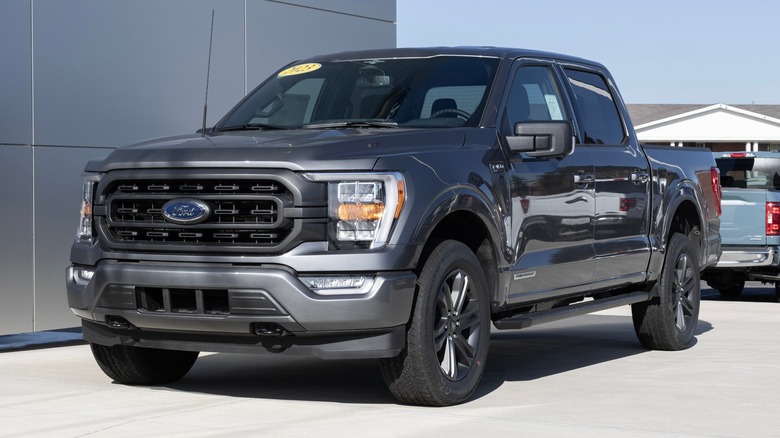
Jonathan Weiss/Shutterstock
Automotive history showcases several of the most impressive Ford engines ever built, like the Boss 429 and Flathead V8.The automaker hasn’t always installed a winner under the hood, however, as one particular iteration is widely considered the worst engine Ford ever put in a truck. The current challenge for those looking to purchase an F-150 is whether to opt for the 3.5L EcoBoost V6 or the larger 5.0L Ti-VCT V8. For the latest models, the 5.0L engine only comes standard on the Tremor and Lariat trims and is optional on the XL, STX, and XLT. Just a few years ago, you could find the V8 standard on Ford’s top-trim F-150 King Ranch and Platinum models, but they now come standard with the 3.5L EcoBoost engine. The EcoBoost V6 is optional on the XL, XLT, Tremor, and Lariat.
When comparing these two engines, the 3.5L EcoBoost V6 offers more torque and slightly better fuel economy than the 5.0L Ti-VCT V8. Surprisingly, the bigger V8 provides slightly less payload capacity, but it’s easier to maintain and is more ideal for lengthy periods of heavy workload. Which engine is better? Ultimately, it depends on what you’re looking for in a truck and how you plan to use it. The smaller EcoBoost features twin-turbochargers, so its acceleration and performance at higher speeds is more thrilling. But, for a daily work truck needed for sustained high-output tasks such as long-distance towing, the V8 might be a better option.
Specifications and reliability
Turbochargers have made it possible to squeeze more energy out of smaller engines. It makes sense then, that the 3.5L EcoBoost is more fuel friendly at an estimated 25 mpg highway, over the slightly less economical 24 mpg highway on the V8. The V8 and the smaller V6 are tied in terms of horsepower at 400 HP, but not in regard to torque. The smaller EcoBoost provides 90 more pound-feet of torque than the V8. The 5.0L engine offers up to 2,230 pounds of payload capacity while the EcoBoost offers a bit more at 2,445 pounds. The 3.5L also outdoes the V8 in towing capability with 13,500 pounds, around 600 pounds greater than the V8.
Both engines are considered reliable with the 5.0L Ti-VCT and the 3.5L EcoBoost debuting in 2011. Timing chain issues effect both engines as well as reported coolant leaks. The first generation of the EcoBoost seems to have the most issues, with reports that heavy towing leads to condensation build-up in the intercooler causing performance problems.
Engine capacity and auditory experience
One of the remarkable aspects of the 3.5L EcoBoost V6 is just how much power Ford has been able to draw out of the relatively small engine. The extra horses and torque are a result of the twin-turbocharger design that forces more air into the engine for enhanced output. While the end result of the EcoBoost is impressive and a great choice for an F-150, the 5.0L’s larger displacement allows for more extensive upgrades. The naturally aspirated 5.0L Ti-VCT V8 has a much higher ceiling in terms of performance potential. For example, you could install a supercharger in the larger V8 and instantly add 50 to 100 additional horsepower. Superchargers offer more power where turbochargers are more efficient. In addition, since the V8 is at the bottom end of its potential capacity, it explains why it might be a better choice for a work vehicle.
The sound of the engine might also impact your decision to go with one choice or another. Since the 3.5L EcoBoost V6 comes equipped with twin-turbochargers, you’ll get the whining or whistling sound while accelerating that’s indicative of the performance-boosting technology. On the other hand, the naturally aspirated 5.0L Ti-VCT will offer the familiar and loud rumble expected of a V8 engine.